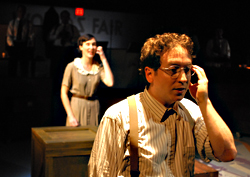How much do I love fringe theater? Well, if you take sex out of the equation, I’ve probably had the most enjoyable moments of my life in a collection of shabby, often ill-heated, cramped black-box theaters. (That’s also where I’ve had some of the worst experiences of my life—again, if you take sex out of the equation.)
Fringe is, to my mind, the roots and soil of all that’s good in Seattle theater, where by far the most interesting productions, greatest experimentation, and most important artists emerge. But sometimes I worry that its call might be fading. The productions I saw this week presented a mixed picture.
Fringe shouldn’t be stuffy, and Open Circle’s production of John Webster’s gory revenge tragedy, The Duchess of Malfi, was by my estimation too reverential to a “classic.” With Johnny Kaufmann—the man who created the goofy planetarium show Starball—directing, you’d think the results would be supremely silly. Someone in this play is killed by kissing a poisoned book, for God’s sake. Another character ends up thinking he’s a werewolf and runs around biting people. Yet this is a production where everyone onstage seemed to be taking themselves far too seriously. I held out hope that members of a madhouse chorus would add some dance steps to their singing, but instead they just ran off to put on some cloaks. Sigh.
Fringe should be different, and Strawberry Theatre Workshop delivers that in their production of David Mamet’s The Water Engine. While the program includes a long essay from Mamet about how wonderful radio theater is—as if we’re about to watch a meticulous re-creation of a 1930s radio script—this production is in no way “authentic.” Director M.J. Sieber dispenses with the usual handheld scripts and onstage sound-effects artist. Most scenes are downstage, with place and props mimed, and the sound effects democratically handed out among the actors not in the scene. What’s created is a huge choral trust exercise, as the actors carefully watch each other to coordinate the sound to the motion.
Fringe should be cheap to produce and cheap to attend. I’m frankly flabbergasted by how good the costumes and set design of The Water Engine look. But I’m just as happy with the thrift-store aesthetic of Seascape With Sharks and Dancer by Absurd Reality Theatre, in large part because the characters in this intense two-hander are sort of thrift-store rejects themselves. Fringe should also be intimate, and when I say that, I don’t mean Intiman Theatre “intimate.” I mean that when Lindsay Crane sat down on the lip of the stage and smoked a cigarette during a reflective moment in Seascape, I could have leaned over and taken a drag. There’s something astonishing about having acting that’s so close and yet so far; it’s less watching than eavesdropping.
Intimate, cheap, different, unpretentious: It’s not much to ask for, really. But fringe theater is one of the only places where I so often see it done so well.
John Longenbaugh




